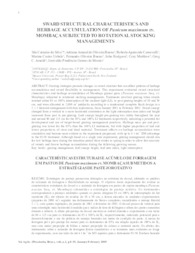Sward structural characteristics and herbage accumulation of Panicum maximum cv. Mombaça subjected to rotational stocking managements.
Sward structural characteristics and herbage accumulation of Panicum maximum cv. Mombaça subjected to rotational stocking managements.
Author(s): SILVA, S. C. da; BUENO, A. A. de O.; CARNEVALLI, R. A.; UEBELE, M. C.; BUENO, F. O.; HODGSON, J.; MATTHEW, C.; ARNOLD, G. C.; MORAIS, J. P. G. de
Summary: Grazing strategies promote changes in sward structure that can affect patterns of herbage accumulation and sward flexibility to management. This experiment evaluated sward structural characteristics and herbage accumulation of Mombaça guinea grass (Panicum maximum Jacq. cv. Mombaça) subjected to rotational stocking managements. Treatments involved grazing when swards reached either 95 or 100% interception of the incident light (LI), to post-grazing heights of 30 and 50 cm, and were allocated to 2,000 m² paddocks according to a randomised complete block design in a 2 × 2 factorial arrangement with four replications, from January 2001 to February 2002. Sward canopy changed from a vertical to a more horizontal orientation as the light interception area index and height increased from post to pre-grazing. Leaf canopy height pre-grazing was stable throughout the year and around 90 and 115 cm for the 95% and 100% LI treatments respectively, indicating a potential for development and use of target-based grazing management practices. Herbage mass pre and post-grazing was lower for the 95% than the 100% LI treatments, but with higher proportion of leaf and lower proportions of stem and dead material. Treatment effects on herbage accumulation were cumulative and became more evident as the experiment progressed, with up to 6 t ha-1 DM advantage to the 95/30 treatment. Although based on a single year experiment, grazing management should aim for low herbage mass during the transition period from winter to spring in order to allow fast recovery of swards and favour herbage accumulation during the following growing season.
Publication year: 2009
Types of publication: Journal article
Unit: Embrapa Dairy Cattle
Keywords: Dossel, Índice de área foliar
Observation
Some of Embrapa's publications are published as ePub files. To read them, use or download one of the following free software options to your computer or mobile device. Android: Google Play Books; IOS: iBooks; Windows and Linux: Calibre.
Access other publications
Access the Agricultural Research Database (BDPA) to consult Embrapa's full library collection and records.
Visit Embrapa Bookstore to purchase books and other publications sold by Embrapa.

